About the Leonberger
Herding Leonbergers
Herding with your Leonberger
For owners who are interested in getting started in herding, the best way to begin is to work with an experienced herding trainer. The trainer will be able to provide individual attention and instruction suited to the particular dog. The stock and the facility will be suitable for beginners as well as for those who have more experience. The lessons aren't necessarily strictly private lessons held in one block of time, but usually involve several short sessions interspersed with rest periods. While the dog is taking a break, the owner can learn by watching other dogs being trained and can visit with other participants.
While individual lessons are best, clinics can be very helpful, being fairly similar to private lessons but providing a broad overview of dogs in various stages of training. Some people get their initial start by having their dog take part in an organized herding instinct test. Instinct tests focus primarily on the beginning step of the first introduction of the dog to stock, but while they should be held in the setting of a clinic, often there is not time for very much individual attention.
Dogs have herding instinct, people don't! — So it is of great importance that the owner learn about herding, stock behavior and care. Herding, while a fascinating undertaking, must be taken seriously. It is not something to be viewed as a weekend sport, occasional hobby or a "fun way to exercise the dog."
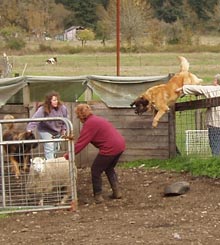
Farryn decides to help out.
Fall 2004
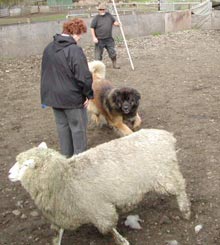
Indy Herds at Annual Herding Day 2004
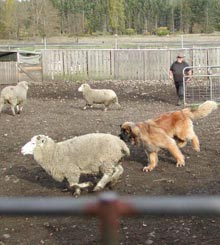
Peaberry herding the sheep.
Fall 2004
After the dog has been introduced to stock and has shown evidence of herding potential, the owner must carefully consider several factors. Is the owner in a position to devote some time to regular herding lessons? With a dog that is mature enough to begin training, usually around a year of age, owners should be in a position to take their dog to stock on a regular basis—at least once a week, preferably two or three times a week. It is unfair to a dog to "tease" it, in effect, with intermittent small tastes of herding, and no real progress can be made under such circumstances. It is also unfair to the stock, for instead of being confronted with a more settled dog, each time they will be subjected to an over-excited dog which will remain strange and upsetting to them. Owners who are unable to become actively involved in herding due to their current circumstances can continue to learn about herding through other means until such time as they can practice with the dog more regularly, and can support herding activities in other ways while gaining an appreciation of the skills of the herding dog.
Because herding will be such potentially exciting activity for the dog, some preparatory steps can be taken to help make the early work with livestock easier for all concerned. It is important that the dog have a good recall and a good stop (sit or down). These must be practiced away from stock, in many situations and with distractions. By doing this preliminary work, the dog gains a working relationship with its owner without the added stress and excitement of the presence of stock. The dog probably will not at first obey the recall and stop perfectly when the introduction to stock takes place, but progress will be much quicker than if the dog did not have solid training to recall and stop. Through use of the stop (which will be a "sit" or "down" command, whichever is easiest for the particular dog), the handler can take pressure off the sheep. The sheep will then be more likely to settle into position more smoothly, and this in turn will help settle the dog. With the stock and sheep more settled, the novice handler can better learn positioning and handling, which in turn helps the dog learn more easily and quickly, which lessens stress on sheep, dog and handler.
Unlike other herding commands, the stop from motion can be practiced at home, away from stock, so it is feasible work for the person who does not have stock of their own. To teach the stop from motion, first a regular sit or down is taught, with the handler relatively stationary. Then, the handler asks for the sit or down while the handler continues walking. Finally, the handler asks for the sit or down while running excitedly, clapping hands, playing with a ball or other toy, etc. It should be done in a happy, play-training fashion, but firmly enforced. If, when first working stock, the dog is virtually out of control, the owner will be asked to work at home on a solid recall and stop before bringing the dog back to stock. Even with calmer dogs, this "homework" remains important and should be practiced daily and in many situations. Ironically, however, while it is important that the dog have a good stop and recall, these commands must not be overused during the early training lessons on stock. The early lessons are focused more on developing the dog's natural herding abilities in collecting the stock and controlling their movement.
Leads for trainers can come from several sources, but a certain amount of searching may be necessary. Some areas of the country have more herding activity going on than others. If local herding activities are available, attend them and meet the participants. There may even be people in local show-oriented breed clubs who, while they may not themselves be involved in herding, know of others in that breed who are. If no leads can be found, a regional or national breed club or herding club can be contacted, for instance, the Australian Shepherd Club of America or the American Herding Breed Association. Such organizations will be able to provide contacts for local clubs and trainers, which will in turn lead to other contacts. Expect to be following a trail of several referrals, rather than getting a trainer's name with the very first contact— although that can happen, too. Read several herding books and articles in herding magazines to gain some familiarity with herding even if some things won't be clear until participation in lessons actually beings.
The trainer should be a person who has a sound knowledge of and experience with herding and has been working stock on a regular basis. It is good if the trainer has had experience with both strong- and loose-eyed dogs, but if more familiar with one type of dog is still open-minded about the other. Such trainers generally look for the fundamental qualities that are common to good herding whatever the breed, rather than focusing too much on supposed particular "breed styles," but they also are aware that dogs are individuals and will tailor their approach to the individual. They work with and shape the dog's natural abilities, help develop its full potential and increase its skills. They strive for good, versatile, practical work, and are concerned about laying a solid foundation. While being aware of trialing venues and probably active in trialing themselves, they don't focus on trial courses per se. They train a dog to herd rather than to run on this or that course. Successful trial results from a variety of venues can be a sign of a good trainer, but there are also trainers who are very good but don't trial to any extent because that is not where their interests lie. In choosing a trainer, it will be helpful if possible to visit one or more trainers, observe some classes and talk to a number of people.
Owners of some breeds may be able to more easily find a trainer knowledgeable about working with their breed. For instance, Border Collie owners often have good trainers readily available. An area where Australian Shepherds have been in common use may have a good range of trainers familiar with Aussies. It may be a case of being lucky enough to be in an area where there happens to be a trainer who is knowledgeable about a particular breed. A benefit of the increasing interest in herding is that there are now more trainers available who are knowledgeable about a variety of breeds.
There are many trainers who are interested in a wide range of breeds, but some trainers who work mostly with a particular breed may be uninterested in working with others. Even the trainers who only want to work with certain breeds can still be a source of good information for owners of other breeds, however. For example, the owner of another breed can attend a Border Collie trainer's clinic as a spectator. Attending a clinic as an observer, whether or not the attendee owns the same breed as the person giving the clinic, is beneficial because much can be learned at a clinic by observing the work of others. And some of the trainers who start out only wanting to work with one breed may become intrigued by other breeds and end up working them as well.
The owner of the prospective herding dog should also consider what the ultimate goals in training might be. A person who just wants a dog capable of doing a simple farm routine may only require some simple basic training. But nowadays there is a great deal of interest in herding as a sport or hobby, and as a result of the demands of competition a more sophisticated kind of training usually is desired. Probably as a result of the amount of trialing done with Border Collies, training techniques were developed by Border Collie handlers to a greater extent than generally was the case with some of the other breeds, which often were used more for routine farm work that could be done with little particular training. As time has gone on, however, techniques first elaborated by Border Collie trainers have spread and have proved to be adaptable to other breeds when the goal is to produce a flexible, well-rounded worker adaptable to a range of situations. But adaptations and adjustments will be made based on the dog's individual characteristics, there may be a different emphasis or focus at different stages of training.
Despite a certain amount of common practice, training approaches can vary between trainers. It is may be the case that one trainer just seems to have the knack of getting across information to you and your dog. There are people who are very good trainers and handlers of dogs but perhaps not as good at communicating their knowledge to the human student. Even the trainer who provides only a low-key observation and an opportunity to practice can play a helpful part in gaining experience once the basics have been learned.
While it's better not to hop around willy-nilly from trainer to trainer, especially at first, it can be beneficial as time goes on to learn from several trainers. Attending clinics is a good way to see a wide range of techniques. It may happen that one trainer may be best for you and your dog at a particular stage of training, but another trainer may have a better way at a different stage. The more techniques you know about, the more knowledge you will have to choose from, which you may eventually apply to a different dog at a later time. It is also a good practice to go to different facilities so that your dog becomes accustomed to working in different locations.
Some trainers prefer to have their student work only with them, particularly in the beginning, while others are amenable to their students also going to others. It is best to find out ahead of time your potential trainer's view on this, so as to avoid possible misunderstandings. If you do go to more than one trainer on occasion, try to avoid any appearance of "arguing" with the trainer you are working with. That trainer may do things differently from your regular trainer, and you may in the end prefer your primary trainer's methods, but you are there to learn from the trainer you are with at the moment, not to convince that trainer of a "better" way. You can, of course, discuss different techniques, but it should be done in a generalized way: "I saw this being tried once" or "I've heard of such-and-such being done, and thought it might work well for my dog.," not, "but my trainer so-and-so says never to do that." If a trainer does something with which you do totally disagree and of such a nature (perhaps a certain kind of correction) that you don't wish to continue, that is another matter, of course. This is rarely the case, fortunately.
You should be able to find a trainer with whom you are comfortable—you like the atmosphere of the facility, you feel the trainer explains him- or herself well, you feel the trainer likes working with your dog, and you see steady progress being made.

Even puppies show herding instinct.
Tir na nOg B Litter puppies.
Fall 2004
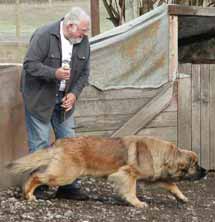
Jerry and Bess get started. Fall 2003
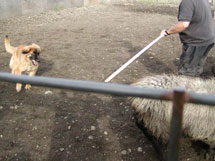
Denali (Laura Jane Spell) in the ring. Fall 2004
